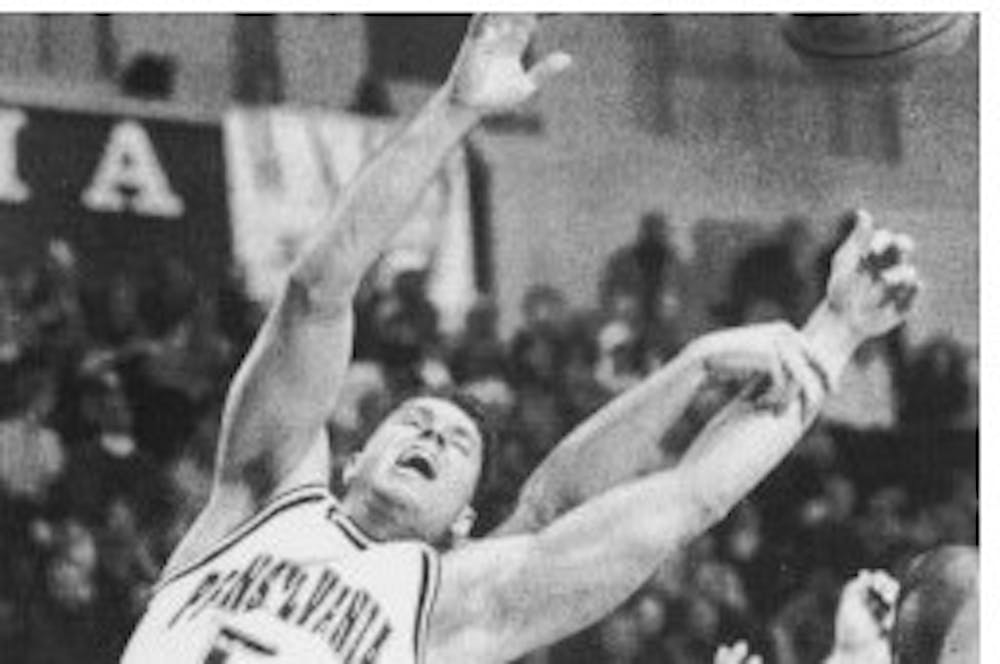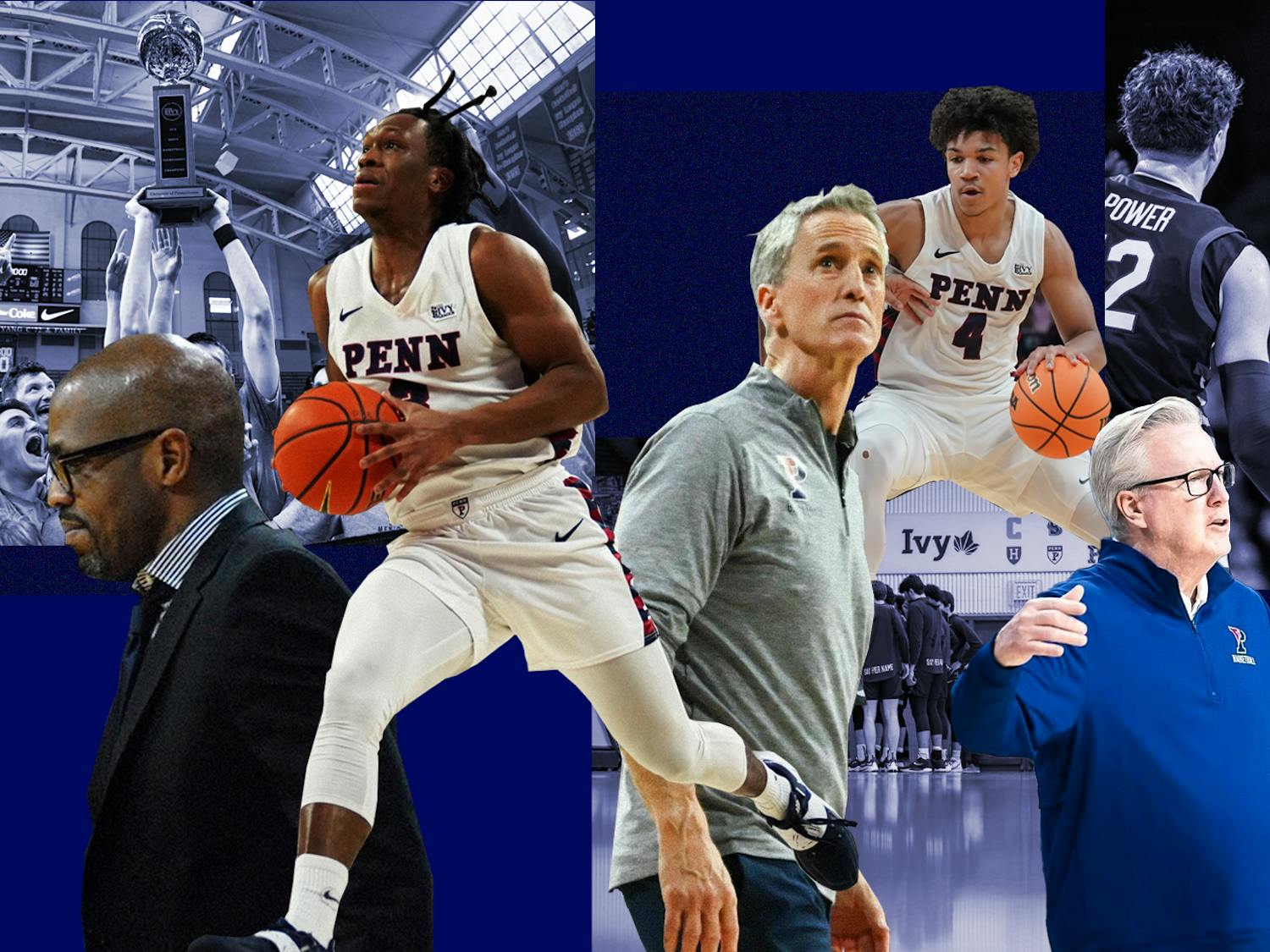Following its second consecutive Ivy League Championship, the 1994-95 Penn men’s basketball team came into the season as clear favorites. With a starting lineup consisting of five seniors, and a streak of 29 consecutive Ivy League wins, there was not much that could stop the Quakers from continuing their dominance.
A critical component to the Red and Blue’s success over the previous seasons was the backcourt leadership of Jerome Allen and Matt Maloney.
The Quakers' strengths, however, didn’t end with those two. Six-foot-six senior guard Scott Kegler was a sharp-shooter in the backcourt, while senior center Eric Moore and forward Shawn Trice held it down in the paint.
“I think night in and night out, we’re going to be taking the best shots from just about everyone in the league,” Allen said at the time. “I don’t think there’s any other role I’d like to be in.”
The Quakers entered with high hopes, but things did not go as planned. In the first game of the season, Penn lost to the underdog Canisius by a score of 81-78.
Coach Fran Dunphy was hoping that this loss would whip his team into shape, but early on in their next game against Lehigh, the Red and Blue looked lost on the court. That was until Jerome Allen woke up, hitting two free throws with 48 seconds left and a jumper with five seconds left to tie the game. Penn went on to win in overtime, 82-79.
“I think it’s great to pull out that type of game,” Kegler said. “We’re now in a position where everyone is going to come after us with nothing to lose, just like Canisius and Lehigh did.”
After breezing by Ohio State and Fairleigh Dickinson, Penn had one of its biggest matchups of the season: the No. 25 Michigan Wolverines. Penn was expected to put up a fight, but no one thought the Quakers would rush out to a 28-7 lead like they did. Michigan tried to come back, but in the final seconds, Allen silenced them with a “10-foot, one-handed hook shot leaner,” as described by junior forward Tim Krug. It was an all-around team win, and the Quakers left the Crisler Center on top of the world.
The following week, at the ECAC Holiday Festival, after beating Colgate and St. John’s, Allen was named the tournament’s most valuable player, joining the company of Oscar Robertson and Bill Russell.
“If you watch him, he won’t dazzle you right away, but for a stretch of the game, he dominates and is the best player on the floor. He either brings you back from a deficit or pulls you away,” Dunphy said about Allen.
With conference play starting, Penn’s first matchups came against Dartmouth and Harvard, and the team won both by good margins.
After a rocky patch with losses to No. 1 UMass and St. Joseph’s, the Quakers got back into their rhythm against their biggest rivals, Princeton, winning by 19 at the Palestra.
At this point in the season, the Quakers had a target on their back. Luckily for Dunphy, however, he could always count on someone to step up. Against Yale, Krug and fellow-junior Ira Bowman had solid performances off the bench. Versus Brown, Maloney scored a career-high 36 points.
Penn went on to beat Dartmouth and Harvard, as well.
“Just about every game, on that blackboard is written ‘respect.’ Respect the game itself. Respect the opponent. And above all, what we want to do is respect the guys at the end of the bench who work their brains off every single day,” Dunphy said. “We’re a more talented team than them...lf we think we’re doing our best, then I’ll settle for that. But I don’t believe that we are.”
After losing a close game to No. 9 Villanova, Penn had five more conference games to focus on. A pattern for Penn’s season had been letting teams get back into games that should’ve been sealed shut, but Penn managed to hold off Cornell and Columbia before returning to Philly for its final two home games.
It was an emotional time, as the Quakers would be saying goodbye to their entire starting lineup, who had gone 40-6 during their four years at Penn. After beating Brown, Penn made quick work of Yale, winning by a score of 82-57 in the send-off for the seniors.
“It isn’t over yet,” Allen said after the game. “Not for myself, not for Shawn, not for Eric, not for Matt, not for Scott. Not for any of us.”
Beating Princeton, 69-57, the Quakers had extended their streak to 43 straight Ivy League conference wins and advanced to the NCAA Tournament for the third year in a row.
Given the 12th seed in the East Regional, Penn was set to face the fifth-seeded Alabama. To win, the Quakers would need a strong performance from its backcourt to capitalize on Alabama’s inconsistency.
Toward the end of the second half, Penn trailed by a score of 57-46, but starting off with an Allen three, Penn went on a 21-10 run to equalize the game. The final minutes were back and forth, but after a couple made free throws by Bowman and a missed shot by Alabama, the Quakers forced overtime.
Unfortunately, Penn couldn’t keep the momentum. Alabama scored the first 11 points, and two Allen threes were not enough to get Penn back in the game. The Red and Blue fell to the Tide, 91-85.
What was an unfortunate ending for the Penn basketball careers of seniors Jerome Allen, Matt Maloney — who was named Ivy League Player of the Year — Eric Moore, Scott Kegler, and Shawn Trice should not be a reflection on their time at Penn. One of the best — if not the best — basketball class in Penn history, their streak of 43 consecutive Ivy League wins and three conference championships will always live on in history.









